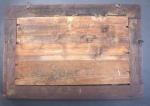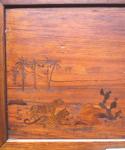-
Posts
13,225 -
Joined
-
Last visited
-
Days Won
22
Content Type
Profiles
Forums
Blogs
Gallery
Events
Store
Everything posted by Mervyn Mitton
-
Megan and Monty. Thankyou for the information on the release of material - and for the great old training film. I see that it was made in 1945 - and apart from the uniform and the marching out to beats - very little had changed when I was at Hendon in 1967. In fact I found it quite nostalgic. Mervyn
-
Chris - AAC stands for Army Air Corps. They were formed in 1942 and included personnel for a number of duties. One of these was flying small planes for spotting - they had an artillery officer on board to watch for fall of shot. They also included Paras in the early days and SAS. I agree with you that the wallet looks Tunisian or, Nth.African - he could have taken the badge as a souvenir in Africa or, perhaps Crete where the German Paras were in force. One interesting point - I don't think the badge is an original one. During the camaign many badges were lost when equipment was captured. This led to the British troops making sand castings - using a genuine badge. Remember, without identification you were not treated as a POW. I would say this is a sand casting. Mervyn
-
Chris - AAc stands for the Army Air Corps - formed in 1942. They included small observer planes with Artillery officers, plus at one time they included Paras and SAS. They served until 1947 and were later reforned and now are active with helicopters. I agree with you that this wallet looks Nth. African - and he probably took the badge from a prisoner. This could have been in Nth. Africa - or, possibly Crete. There is one interesting point about this badge - I don't think it is the original casting. Our troops ran out of badges when equipment was lost and they were not high on the list of stores for the convoys. The troops took to making sand castings - using a
-
Terry - the 80th Regiment of Foot were the South Staffordshire Regiment. I am in the shop tomorrow and will check a few ref. books. With the markings this becomes a valuable piece. At one point - after Isandlawana - the Zulus had more Martini Henrys then the British Forces. Fortunately, most had the sights set for distance and they were not terribly accurate. Ones that have been recovered from Zululand often have carvings on the body and are also covered with beadwork. Chris makes a good point about old items being destroyed for their value. However, from our point of view as collectors - this makes them more valuable. Mervyn ps. Your local Police forensic unit can often help with obscured lettering and numbers. Sometimes, just a little chalk dust will help.
-
I am starting 2013 with a very rare German POW piece of marquetry. This was from a prisoner taken during the 1916 campaign to capture German South West Africa. Mainly this was a South African campaign - fought with local troops. When we had captured the territory, most troops took their discharge to join other newly formed units that went on to fight in France and in German East Africa. With the end of World War 1 the newly formed League of Nations awarded South Africa a Protectorate over the area - this continued until the newly created Namibia came into being a few years ago. We knew it as South West Africa. Over the years I have seen many examples of work carried out in prison camps - the Boer War really being the point where it became popular. Rarely have I seen one with the artistry of this example. The small silver plate shows that the prisoner must have given it to a Guard - quite a common occurence - and he has had it framed and had the plate made to show it's origins. The dates are probably for the period the guard served at Fort Napier. The Fort itself is one of the oldest from the old colonial Natal. Originally built in 1848 to guard the newly acquired town of Pietermaritzburg - the Boers having left to settle in the Transvaal. The town was originally named after the two Boer leaders who founded it - we, the British, would not call it by that name - in fact our name was Umshlovo - or, Place of the Elephants. We made it the capital of Natal, and eventually the name reverted to the original. Fort Napier was named after Sir George Napier - then the Governor of the Cape. It's first garrison was from the 45th Regt. of Foot and also included Royal Engineers, Cape Mounted Police and a half battery of Field guns. They were intended to deter the Boers returning and to keep local tribes in order. The 1st WW saw the large area of the Fort and it's many buildings being used to house POW's and also Germans who were being interned from around SA. + from other nearby African countries. The military use finished in 1920, although the Fort is still preserved and houses the Garrison Church. The majority of the area though, is given over to a a mental institute. POW's were often allowed to have a small knife for use in making things - some of them beautifully worked and very artistic. This panel shows two leopards behind rocks and watching a giraffe feeding on a thorn tree. This is very similar to the desert areas of SWA and has been very well executed. The art of marquetry is setting small pieces of different woods into a bigger piece - and then polishing or, varnishing. Make a mistake and it is difficult to put right. I will show a series of pictures so that you can see how it was made. ..............................................http://gmic.co.uk/uploads/monthly_12_2012/post-6209-0-42418900-1356962784.jpgclick.....................................
-
Oleg - a lovely collection - and good that you have so many with suspension belts. Welcome to GMIC and I am sure your posting will bring a lot of replies - and hopefully more pictures of collections. Mervyn
-

Looking for soldiers
Mervyn Mitton replied to The Prussian's topic in Great Britain: Research, Documentation & History
Andy - I'll clear my IM box - damn thing filled up with the photo comp. Mervyn -

belt plates etc
Mervyn Mitton replied to blueman's topic in Great Britain: Militaria: Badges, Uniforms & Equipment
Kevin - I can give you prices. Will IM. Mervyn -

Looking for soldiers
Mervyn Mitton replied to The Prussian's topic in Great Britain: Research, Documentation & History
Andy - thanks to Timo you seem to have your immediate questions answered. I am quite happy to pay for these records that you need access to - please find out the cost and IM me. Mervyn -
Terry - thankyou for posting these assegais - and welcome to GMIC. We have quite a good following on this thread - although I think many are from overseas as we are followed by quite a few schools and universities. These are of a generic type for that period (1870's) and there is nothing to link them with Kambula. However, it is also quite possible that they are. General Sir Evelyn Wood VC, was the commander at that battle - the first we were succesful-in - and it changed the War in our favour. I know the farmer who owns the land at the base of the hill and he says they often turn-up old Zulu weaponry. We do not know the exact numbers of Zulus killed - however, it is thought to well exceed 2000. After the battle the British soldiers dug 3 large and deep pits and the dead - and their weapons were thrown-in and covered. Today, the locals dig at night and sell pieces to the tourists - all illegal of course. Your weapons are as follow: a) An Iklwa - with Ilala palm binding. The length of the spear was a preferance of the owner. Has a nice head b) This has a very small head - but then, iron was expensive and it may be due to cost. Nice shaft. The alternative is a hunting spear. c) This has a very small head and would indicate a spear for bird hunting. The knob at the end would balance the flight. d) This could be an Isiphapha - or , throwing spear. However, the Ilala binding has come adrift and I can't be sure. Usually a long neck. e) An excellent example of a Zulu made axe - shaped like a hoe. This-and © have a cow's tail binding. Axes were only carried by chiefs. Hope this of help. Mervyn
-

belt plates etc
Mervyn Mitton replied to blueman's topic in Great Britain: Militaria: Badges, Uniforms & Equipment
If these came with the HLI shako - then you have done very well. The set of three are cross belt plates for the shoulder ceremonial belt. I'm not sure about the two on the ends - however, the centre one is the 1st Battalion the Argyle and Sutherland Highlanders - the 91st of Foot. The others appear to have either a Ducal coronet or, an Earl's. This could well link them with the Argyles - perhaps the officer had these whne he first joined. Needs looking up ? The centre front plate of a dress waist belt is obviously, Victorian and with the Royal motto. The gilding and the oak leaves indicate that it was for a senior officer. Perhaps it is the same man and he became a General ? The Gordon Highlanders is your remaining officers waist belt. For prices I think you should speak to Christies or, Bosley's in London. Mervyn -

scottish shako
Mervyn Mitton replied to blueman's topic in Great Britain: Militaria: Badges, Uniforms & Equipment
Kevin - it could possibly fetch more - however, you need to clean it up. Try some boot polish on the scruffed leather. Only two Scottish Regiments used the shako - the Cameron's and HLI - I recently sold both for this same period. Mervyn -

scottish shako
Mervyn Mitton replied to blueman's topic in Great Britain: Militaria: Badges, Uniforms & Equipment
This is for the Highland Light Infantry. Boer War period - but not issued until after 1902 - hence the crown for King Edward 7th. Value wise about 150 pounds in this condition. Mervyn -
Most Police Stations had a Lamp Room - staffed by a retired officer (or, close to retiring). Lamps were handed in after night shift and they were cleaned and filled ready for the next night shift. This was certainly so for the Met. and I expect County Forces - in their main stations would have done the same. Brian's flat top lamp is probably Scottish. Mervyn








